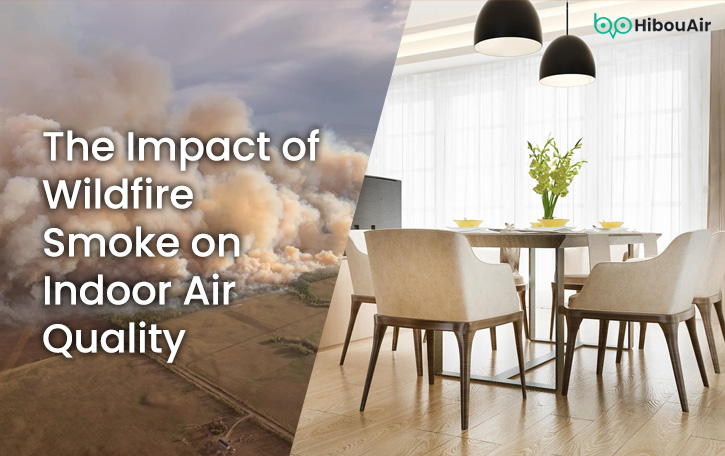The impact of wildfire smoke on indoor air quality: How HibouAir can help
Wildfires have become increasingly frequent and intense due to climate change, posing significant threats not only to outdoor air quality but also to the indoor environments where we stay. Understanding the impact of wildfire smoke on indoor air quality is crucial for safeguarding our health. This is where HibouAir, a comprehensive air quality monitoring device, comes into play. With its array of sensors and smart analytical dashboard, HibouAir offers real-time and historical data to help you maintain a healthier indoor environment during wildfire events.
Understanding Wildfire Smoke and Its Components
Wildfire smoke is a complex mixture of gases and fine particles produced by the combustion of vegetation and other materials. The key pollutants in wildfire smoke include particulate matter (PM1.0, PM2.5), which can penetrate deep into the lungs, causing respiratory and cardiovascular issues; carbon dioxide (CO2), which at high levels can displace oxygen in the air and lead to health problems; volatile organic compounds (VOCs), which are gases emitted from burning vegetation and materials that can cause short- and long-term health effects; and other gases such as carbon monoxide (CO), nitrogen oxides (NOx), and ozone (O3), which can exacerbate respiratory conditions and other health problems.
How Wildfire Smoke Affects Indoor Air Quality
Wildfire smoke can infiltrate indoor spaces through windows, doors, ventilation systems, and even tiny cracks in buildings. Once inside, the pollutants can linger and accumulate, leading to poor indoor air quality. This is particularly concerning for vulnerable populations such as children, the elderly, and those with pre-existing health conditions. The primary effects of poor indoor air quality due to wildfire smoke include increased incidence of asthma attacks, bronchitis, and other respiratory conditions; elevated risk of heart attacks and other cardiovascular diseases; irritation and inflammation of the eyes and skin; and reduced cognitive function, which can affect concentration and productivity.

Photo credit : https://www.nytimes.com/
Expert Insight: Dr. Joseph Allen on Indoor Air Quality During Wildfires
Wildfires significantly impact both outdoor and indoor air quality, introducing pollutants that can infiltrate homes and buildings. Dr. Joseph Allen, Associate Professor at the Harvard T.H. Chan School of Public Health and Director of the Healthy Buildings Program, emphasizes that simply staying indoors during wildfire events is insufficient without proper air quality management.
Monitoring and Mitigating Indoor Air Quality with HibouAir
HibouAir provides a robust solution to monitor and improve indoor air quality during wildfire events. The device is equipped with sensors that measure various air quality parameters, including CO2, PM1.0, PM2.5, PM10, pressure, temperature, humidity, and VOCs. This comprehensive monitoring allows you to detect the presence and concentration of harmful pollutants from wildfire smoke. HibouAir provides real-time air quality data, enabling you to take immediate action if pollutant levels rise, which is crucial during wildfire events when air quality can deteriorate rapidly. Additionally, HibouAir’s analytical dashboard stores historical data, helping you identify trends and assess the effectiveness of air quality improvement measures over time.
Practical Steps to Improve Indoor Air Quality
With customizable alerts, HibouAir can notify you when air quality parameters exceed safe levels, allowing you to respond promptly to protect your indoor environment. The smart analytical dashboard offers insights and recommendations for improving air quality, such as optimizing ventilation, using air purifiers, or sealing gaps in the building envelope. In addition to using HibouAir, there are practical steps you can take to protect your indoor air quality during wildfire events. These include sealing your home by closing windows and doors and using weather stripping to prevent smoke infiltration; investing in high-efficiency particulate air (HEPA) purifiers to filter out fine particles from the indoor air; optimizing ventilation by using air conditioning systems with high-quality filters and setting them to recirculate indoor air; and limiting indoor activities that can worsen air quality, such as burning candles, using fireplaces, or cooking with gas stoves.
Wildfire smoke poses a significant threat to both outdoor and indoor air quality. By understanding the impact and utilizing advanced monitoring tools like HibouAir, you can protect your indoor environment and health. HibouAir’s comprehensive monitoring, real-time data, and actionable insights make it an indispensable tool for maintaining a healthier indoor environment, especially during wildfire events. Investing in air quality monitoring and improvement measures is not just a choice but a necessity for ensuring long-term health and well-being.
References
- Wildfires and Indoor Air Quality (IAQ) – https://www.epa.gov/indoor-air-quality-iaq/wildfires-and-indoor-air-quality-iaq
- Impact of Wildfire Smoke Events on Indoor Air Quality – https://aaqr.org/articles/aaqr-21-03-tn-0046
- Canadian Wildfire Smoke (Inside Climate News) – https://insideclimatenews.org/news/14052024/todays-climate-canada-wildfires-smoke-america-indoor-air-quality/
- Wildfire smoke impacts on indoor air quality assessed using crowdsourced data in California – https://www.pnas.org/doi/10.1073/pnas.2106478118
- Wildland Fires and Smoke – https://www.epa.gov/air-quality/wildland-fires-and-smoke

